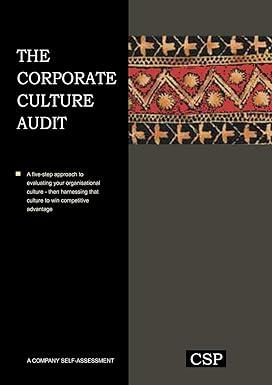Question
Sherene Nili manages a company that produces wedding gowns. She produces both a custom product that is made to order and a standard product that
Sherene Nili manages a company that produces wedding gowns. She produces both a custom product that is made to order and a standard product that is sold in bridal salons. Her accountant prepared the following forecasted income statement for March, which is a busy month: Custom Dresses Standard Dresses Total Number of dresses 10 20 30 Sales revenue $ 48,500 $ 28,500 $ 77,000 Materials $ 9,700 $ 7,700 $ 17,400 Labor 19,700 8,700 28,400 Machine depreciation 570 270 840 Rent 3,900 2,500 6,400 Heat and light 1,100 700 1,800 Other production costs 2,500 Marketing and administration 7,400 Total costs $ 64,740 Operating profit $ 12,260 Ms. Nili already has orders for the 10 custom dresses reflected in the March forecasted income statement. The depreciation charges are for machines used in the respective product lines. Machines depreciate at the rate of $1 per hour based on hours used, so these are variable costs. In March, cutting and sewing machines are expected to operate for 840 hours, of which 570 hours will be used to make custom dresses. The rent is for the building space, which has been leased for several years at $6,400 per month. The rent, heat, and light are allocated to the product lines based on the amount of floor space occupied. A valued customer, who is a wedding consultant, has asked Ms. Nili for a special favor. This customer has a client who wants to get married in early April. Ms. Nili's company is working at capacity and would have to give up some other business to make this dress. She can't renege on custom orders already agreed to, but she can reduce the number of standard dresses produced in March to 10. Ms. Nili would lose permanently the opportunity to make up the lost production of standard dresses because she has no unused capacity for the foreseeable future. The customer is willing to pay $23,500 for the special order. Materials and labor for the order will cost $5,700 and $9,700, respectively. The special order would require 125 hours of machine time. Ms. Nili's company would save 135 hours of machine time from the standard dress business given up. Rent, heat and light, and other production costs would not be affected by the special order. Required: a-1. Calculate the differential operating profit (loss) without the special order, With the special order and the impact
. a-2. From an operating profit perspective for March, should Ms. Nili accept the order? Yes No b. What is the minimum price Ms. Nili should accept to take the special order?
Step by Step Solution
There are 3 Steps involved in it
Step: 1

Get Instant Access to Expert-Tailored Solutions
See step-by-step solutions with expert insights and AI powered tools for academic success
Step: 2

Step: 3

Ace Your Homework with AI
Get the answers you need in no time with our AI-driven, step-by-step assistance
Get Started


